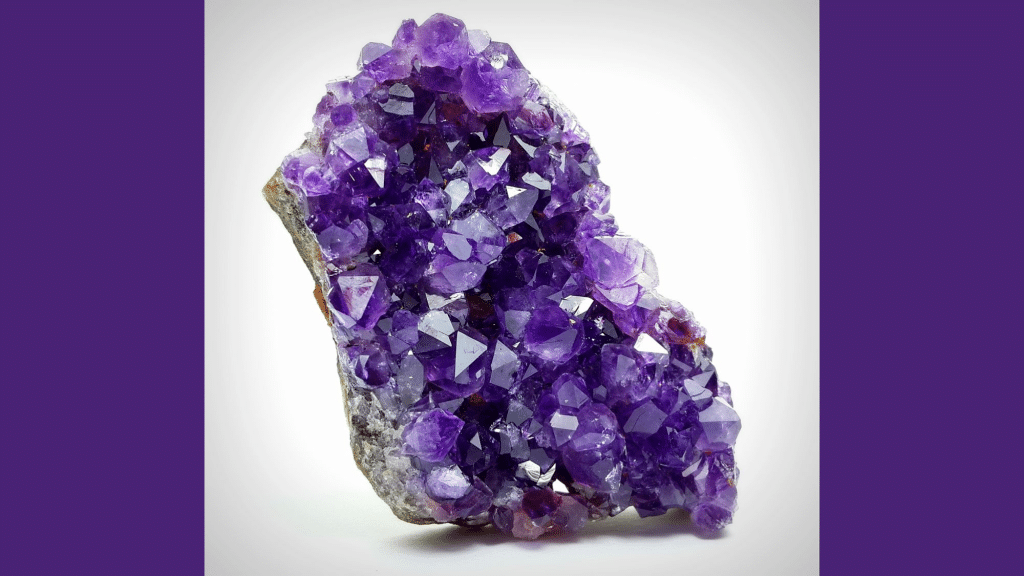Did you know that amethyst, with its beautiful purple color, has been holding people’s attention for thousands of years?
Well, this beautiful crystal, part of the quartz family, is loved in jewelry and collections all over the world.
From its impressive color shades to its spot in royal crowns, amethyst has an interesting history that’s worth knowing.
More than just its beauty, amethyst’s unique qualities and cultural importance make it one of the most cherished stones worldwide.
Let’s take a look at some fun facts about what makes amethyst so special and why it’s still loved today.
1. Enormous Amethyst Formations
Amethyst crystals can grow to massive sizes, with some geodes reaching over 10 feet tall and weighing thousands of pounds.
The Amethyst Cathedral in Brazil is a famous example. It features beautiful crystal formations that took millions of years to form through slow mineral accumulation in hollow rock cavities.
2. Ancient Egyptian Connections
Ancient Egyptians valued amethyst for its protective powers and spiritual meaning.
They carved amethyst into amulets shaped like gods or sacred animals and placed them in tombs to guard against harm and bad luck in the afterlife.
This crystal jewelry, like beads and scarabs, was often buried with important people to help guide and protect their souls on their journey after death
3. Traditional Healing Properties
Throughout history, amethyst has been associated with various healing abilities. Some traditional beliefs suggest:
- It helps with headaches and reduces stress when placed under pillows.
- It supports mental clarity and emotional balance for those who wear it regularly.
4. Russian History
Russia’s Catherine The Great sent thousands of miners to the Ural Mountains after amethyst was found there, showing her strong preference for the purple gem.
She commissioned numerous items for her royal collection, including jewelry, decorative boxes, and even furniture inlays featuring the stone.
5. Durability Characteristics
| Amethyst Hardness | Value on Mohs Scale |
|---|---|
| Rating | 7 out of 10 |
| Comparison | Harder than quartz |
| Practical meaning | Good for daily wear |
| Care needed | Avoid harsh impacts |
6. Color Science
Iron impurities within quartz create amethyst’s purple hues. Natural radiation affects these iron atoms, producing colors from light lavender to violet.
The amount of iron and radiation intensity affect color intensity. Some stones show patches of stronger and lighter coloration throughout their structure.
7. Formation Temperature
| Aspect | Details |
|---|---|
| Locations | Uruguay, Brazil, Russia (Siberia), United States, India, Australia, Mexico |
| Temperature Range | 15°C – 60°C |
| Scientific Significance | Much lower than previously estimated |
| Impact on Science | Challenged prior geological theories |
| Key Outcome | Revised understanding of the conditions required for gem-quality crystals to form |
8. Greek Name Origin
Amethyst’s name comes from the Greek word amethystos, which means “not intoxicated” or “not drunk.”
The ancient Greeks believed that wearing amethyst or drinking from cups made of it could protect a person from becoming drunk and help maintain clear thinking.
This belief likely arose because the stone’s purple color resembled diluted wine, symbolizing moderation and sobriety.
Additionally, myths about Dionysus, the god of wine, tell of amethyst as a symbol of protection against his drunken rage, reinforcing its association with preventing intoxication.
9. February Birthstone
Amethyst is February’s purple birthstone, symbolizing stability and inner strength for those born this month.
- This connection appears in ancient birthstone traditions.
- Wearing it reportedly provides February-born people with courage and peace.
10. Crystal Growth Patterns
This typically forms in pyramid-shaped crystal clusters. Inside geodes, these crystals grow inward, creating hollow spaces lined with purple points.
The slow growth process creates distinctive formations. Some large specimens contain internal chambers filled with thousands of individual crystal points.
11. Color Variation Bands
| Aspect | Description |
|---|---|
| Appearance | Bands of varying purple intensity |
| Formation Cause | Growth condition changes during crystal development |
| Primary Factors | Temperature fluctuations and chemical changes |
| Result | Unique pattern in each stone |
12. Global Sources
It is mainly found in these countries and is sold all over the world:
- Brazil and Uruguay are major producers of high-quality amethyst
- Russia, Zambia, and Madagascar represent other significant sources
- Each region’s amethysts display distinctive characteristics
- Brazilian specimens typically show higher purple coloration
- African amethysts often contain subtle reddish undertones
Mining location impacts the specific color tone of each stone
13. Medieval Military Use
Medieval knights and soldiers often wore amethyst amulets around their necks or carried them into battle, believing the stone would protect them from harm and bring good luck.
They thought amethyst would help them stay calm, focused, and courageous during the chaos of combat.
The purple gem was also seen as a charm against negative energies and bad effects on the battlefield
14. Crystal Scepters
Rare amethyst “scepters” occur when crystals grow atop quartz points. These unusual formations happen when mineral conditions change during the growth process.
Collectors highly prize these unique crystal structures. Their rod-like shape resembles ceremonial staffs, hence their royal-inspired name.
15. Religious Symbolism
Christian bishops traditionally wore amethyst rings as symbols of purity. The purple stone represented spiritual wisdom and humble service in the church hierarchy.
Religious jewelry often featured this violet crystal. Its color matched certain sacred garments, connecting it to spiritual authority and devotion.
16. Biblical Significance
Amethyst was one of twelve stones in the High Priest’s breastplate. Known as “Aḥlamah” in Hebrew texts, it was connected to spiritual insight and divine communication.
Ancient Jewish traditions associated it with prophetic dreams. The stone’s placement in sacred garments emphasized its importance in religious ceremonies.
17. Volcanic Creation
Most amethyst forms in volcanic rocks as gas pockets fill with minerals. As lava cools, bubbles remain, later filling with silica-rich fluids that create crystals.
These gas cavities provide space for crystal growth. Over time, iron-containing solutions deposit the materials needed for purple quartz formation.
18. Water-Based Growth
Amethyst also grows in rock cracks filled with mineral-rich water. Hot solutions move through these spaces, gradually building crystal layers as they cool.
These water-filled fractures allow crystal expansion. The slow cooling process creates optimal conditions for the development of large, clear crystals.
19. Growth Layers
Some amethysts show ring-like patterns similar to agate. These layers form as conditions shift during crystal formation, creating visual records of growth phases.
Each band represents a different growth period. Scientists study these patterns to understand the changing conditions during the stone’s formation.
20. Economic Impact
| Aspect | Details |
|---|---|
| Job Creation | Employed in countries like Brazil and Uruguay |
| Community Support | Supports local communities in mining regions |
| Economic Contribution | Adds to regional economic stability |
21. Modern Research Methods
Scientists use oxygen isotope analysis to measure the specific types of oxygen atoms in amethyst crystals. Which helps determine the temperature and type of water present when the crystals formed.
These studies have shown that many amethyst geodes grew at surprisingly low temperatures, often from groundwater, rather than from hot volcanic fluids.
This method also helps scientists match amethyst samples to their original geological settings, revealing details about the local environment and the source of the fluids that created the crystals.
Note: Amethyst is a beautiful purple stone with an interesting history. The next time you see an amethyst, think about its long journey from volcanic rock to the lovely crystal you can hold.















